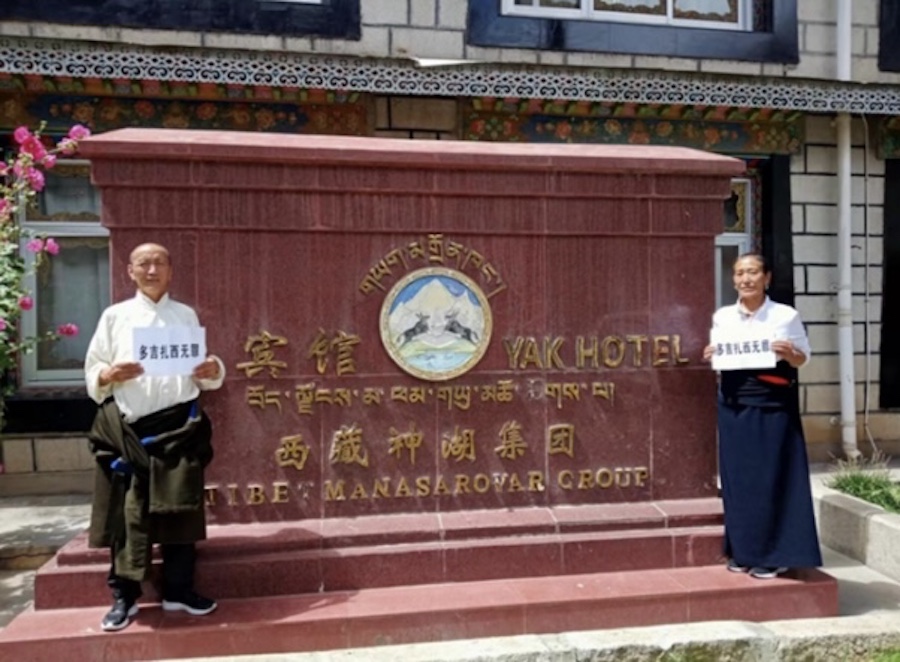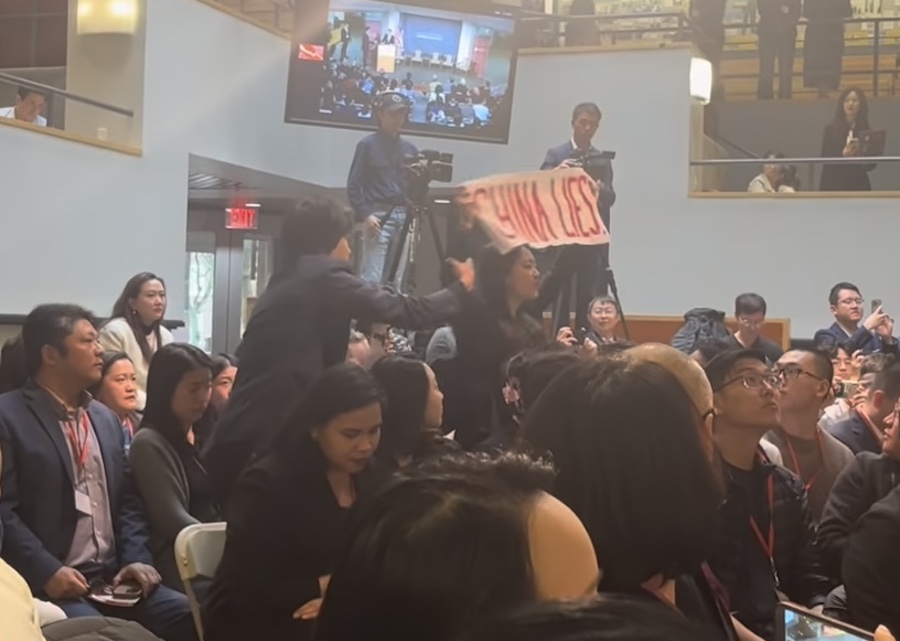by Kate Saunders
On a remote hillside, a Tibetan woman mourns for her mother as flames consume hundreds of bodies in a mass cremation of the dead after a devastating earthquake that hit a Tibetan area of China last Wednesday. A cameraman from the state media who is shooting footage of the grief-stricken Tibetans, with the chanting of hundreds of monks in the background, clearly doesn’t know that the Tibetan woman he is filming is praying to the Dalai Lama.
It is a moving reminder of the often hidden, but agonizing separation of the Tibetan people from their exiled leader, but also of the devotion to him and strong Tibetan identity that endures in his absence.
The death toll from the earthquake that hit a Tibetan area of China last Wednesday is rising daily, and the official count is now more than 2,180, although Tibetans in the area say it is far more. The images of hundreds of maroon-robed monks digging in rubble with their bare hands, disposing of corpses or praying for the dead, focused attention on the crisis as a Tibetan one, in contrast to the headlines worldwide of an earthquake in “western China.”
More than a week later, many are unaware that the earthquake actually occurred in the eastern Tibetan area of Kham, in a region officially recognised by China as Yushu Tibetan Autonomous Prefecture, and which is inhabited mainly by Tibetans. Some media reports used Chinese transliterations of Tibetan names for their interviewees or to name those who had died. Tibetan writer Tsering Wangmo, whose family is from the area, says: “As well as providing funds for rescue and relief, we can also help the people by remembering them by their real names.”
The epicenter of the 6.9 magnitude earthquake was a sparsely populated, rural area about 50 km west of Jyeku (Chinese: Jiegu) town in an area known to Tibetans as Kyegundu in present-day Yushu, Qinghai Province. The Chinese map replaces the traditional “three regions” of Tibet – Kham (eastern Tibet), Amdo (northeastern Tibet) and U-tsang (the latter roughly approximating central Tibet, the present-day Tibet Autonomous Region). Most of Qinghai, including the earthquake zone, is officially designated by the Chinese authorities as “Tibetan.”
Years of suppression by the Chinese government following its takeover of Tibet in 1949-50, and the influx of Chinese migrants, particularly into urban areas, have not diminished the Tibetan identity in Kyegundu and other parts of Kham.
Of the political leaders to send condolences to the Chinese government, including US Secretary of State Hillary Clinton, British Foreign Secretary David Miliband and German Chancellor Angela Merkel, only two – US Speaker Nancy Pelosi, a long-time friend of the Dalai Lama, and US Senate Foreign Relations Committee Chair John Kerry – mentioned that the earthquake had struck in a Tibetan area. Condolences were addressed to the Chinese Communist government, not to the Dalai Lama, although he is recognised internationally as the legitimate representative of the Tibetan people, and those suffering in the earthquake zone yearn for his presence.
It is not only the loss of lives from the earthquake that is devastating, but the impact on Tibetan religious culture, imperiled even prior to April 14th due to China’s political and strategic objectives in the region. Kyegundu’s landscape is scattered with remote hermitages, ancient monasteries and religious settlements. The destruction of monasteries, such as the 1300-year old Thrangu (www.thranguemergency.org), and the death of monks, further deepens Tibetans’ sense of dispossession and loss. Religious faith and devotion to the exiled Dalai Lama are fundamental to Tibetans’ sense of identity, despite the political strictures imposed by the Chinese government that have become ever more stifling in recent years.
So many have died in Kyegundu as a result of the earthquake that traditional “sky burials” for each individual, where the body is consumed by birds of prey, have not been possible. The vultures are too glutted, Tibetans told foreign correspondents in the area last week. Instead, Tibetans who died are being cremated, with hundreds of monks gathering to dispose of the corpses and carry out traditional religious rituals.
Since a wave of protests against Chinese rule swept across Tibet in March, 2008, there has been an intensified military buildup across the plateau. But when the earthquake happened, troops in Yushu were forced to shift their focus from the requirement to suppress dissent and unrest (termed protecting “stability”) to a massive relief and rescue operation.
Premier Wen Jiabao’s emotional visit to the earthquake zone was shortly followed by that of President and Party Secretary Hu Jintao, who cut short an important overseas visit to go to Yushu. Analysts believe that a chief concern of the leadership is that the natural disaster should not exacerbate ethnic tension in Tibet (Willy Lam, http://asiasentinel.com/index.php?option=com_content&task=view&id=2411&Itemid=164), but China’s intensive propaganda drive seems only to expose the Party’s unease about the fragility of the situation in Yushu, while the blanket coverage of the day of mourning this Thursday (April 22) underlines its efforts to drown out critical voices, such as Chinese bloggers. For instance, both Chinese and Tibetan bloggers have pointed out the collapse of shoddy, “tofu” buildings in the quake such as schools, which had happened before in Sichuan.
Certainly the authorities are treading carefully with their handling of the aftermath of the quake. When asked about a possible visit of the Dalai Lama – who has pointed out he was born in Qinghai, the province where the earthquake struck – the state news agency Xinhua noted the request (http://dalailama.com/news/post/521-his-holiness-the-dalai-lama-eager-to-visit-earthquake-affected-area) without any negative comment, in contrast to the usual vilification of the exiled Tibetan leader, saying only: “The government fully respected local religious beliefs and customs, and was offering counseling.” (http://news.xinhuanet.com/english2010/china/2010-04/20/c_13259997.htm)
In this political context, the Party’s approach to the involvement of large numbers of Tibetan Buddhist monks in the relief efforts is of particular significance. For many years, but particularly since March, 2008, the Beijing authorities have sought to prevent large gatherings of Tibetans for fear of unrest and as part of their strategy to ensure control. But in Yushu, hundreds of monks have been arriving from monasteries throughout the area to work on relief efforts, often side by side with People’s Liberation Army troops, and from different Tibetan Buddhist schools, and pray for those who have died. These monks are actively engaged in exactly those constructive, community-building activities that are needed on the ground now – representing a challenge to the state as it seeks to convey the impression that the Party is the sole benefactor and architect of the region’s rebuilding.
New reports, backed up by some Tibetan sources, indicate that some of the monks participating in the rescue operations are being told to leave by the authorities (http://www.rfa.org/english/news/china/gohome-04202010144941.html), although it is not clear how many monks are affected nor the reasons why. The authorities have denied these reports.
Tibetan monks have traveled from monasteries in remote areas, sometimes a couple of days journey away from the epicenter of the earthquake, and are giving cash to victims as well as food and supplies. They are also compiling their own list of the dead from different monasteries and lay society, which sometimes conflicts with the official accounts. A senior monk from Jyeku monastery, the largest in the town, told a Hong Kong journalist that 2,110 bodies were cremated last Saturday, the first day of large-scale funeral ceremonies.
A lama named as Longzhi was quoted by the South China Morning Post as saying: “We are living Buddhas and people here respect us. There is so much we could do. Even with rescue work, since we are from places of high altitude, we could help with rescue work immediately. Instead, in most places where there were soldiers we were not allowed to help. We could only help dig in places where there were no government rescue workers yet.” In a reference to Hu Jintao’s slogan of a “harmonious society”, Longzhi (a Chinese transliteration of a Tibetan name) concluded: “We talk about unity and harmonious society. Religion is an essential part of it. This is what religion is for.” (“Monks plan independent tally of dead”, South China Morning Post, Apr 20, 2010, http://www.scmp.com/portal/site/SCMP/menuitem.2af62ecb329d3d7733492d9253a0a0a0/?vgnextoid=4a56d101fb618210VgnVCM100000360a0a0aRCRD&ss=China&s=News)
There has also been distress that the role of monks in the rescue and relief work has been “air-brushed” out of the official coverage, even though many reports from the area indicate that Tibetan monks were often the first on the scene to assist Tibetans directly. (http://www.google.com/hostednews/ap/article/ALeqM5gdspdDB0WaMv_An4A-NvHB_DwmCwD9F7IEB80). The Communist Party paper the People’s Daily even complained that Western media agencies published too many photos of the help from Tibetan monks (http://chinatibet.people.com.cn/6958633.html) .
One Chinese blogger wrote: “Yushu is a Tibetan Autonomous County [sic], and many of the residents believe in and revere the Dalai Lama, and as such the disaster area is being seen as a highly sensitive area. When the authorities stopped the lamas from taking part in the rescue, it was obvious that politics is more important than life.” (“Aside from lowering the flag to half-mast in mourning, what else must the government do?” http://blog.ifeng.com/article/5041705.html).
The rescue and relief operation by the state and the continuing efforts of Chinese troops and official teams in Yushu are vital. But established local groups also have an important role in helping Tibetans on the ground. Reports indicate the precarious nature of their work, with local NGOs subject to surveillance and uncertainty about access for outside organisations to help with relief efforts.
Funds are particularly needed for mid to long-term relief, as well as immediate supplies of food and medicine. There is a need for temporary shelter building, sanitation, community training, micro-credit systems, micro-business start-ups, medical after-care teams for amputees, the re-building of schools and community centers, among others.
Virtually the entire town of Jyegu was flattened in the quake, and the authorities are said to have already completed a survey and plan for its rebuilding. Providing long-term support for the Tibetan community now is essential to increase the chances of Tibetan involvement in such decision-making.
Tibetan poet Tsering Wangmo, who lives in exile in the US, posted this on her Facebook page a few days ago: “As I write this, the sick are being air lifted out of Kyegu’s small airport to be treated in hospitals in Chengdu, Xining, Lanzhou and other cities; thousands of homeless Tibetans and a small population of migrant Chinese are having a bowl of instant noodle soup as a meal; many people are still looking for their missing family members under the rubble of buildings. This is just the beginning of a long and difficult journey for a community that has gone through so much. It is my hope we can help them get through the immediate crisis and be there to help them rebuild the town and their lives.”
Support for organisations now working on the ground to help Tibetans is critical.
You can give direct help to Tibetans there now by donating to ICT’s earthquake appeal at
www.savetibet.org or www.savetibet.de
http://www.yushuearthquakeresponse.org/
http://www.justgiving.com/Yushu-Earthquake-Relief-Fund*
www.machik.org *
www.tibetanvillageproject.org









